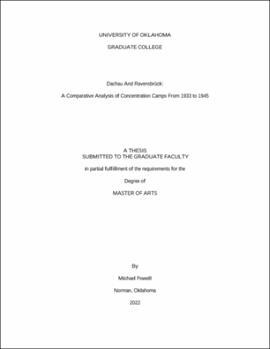| dc.description.abstract | Comparing and contrasting the two infamous camps, Dachau and Ravensbrück, is fundamental in understanding the true nature of the two camps. Additionally, this research indirectly focuses on the question of ‘what defines a death camp versus a concentration camp?’ Using primary source material, specifically concentration camp survivors’ memoirs and Google Earth imagery, this comparative study of Dachau and Ravensbrück addresses key distinctions between the two camps in Nazi Germany. Although Dachau was built in 1933 and Ravensbrück in 1939, the two camps shared a characteristic of imprisoning only a single sex: Dachau imprisoned males, while Ravensbrück imprisoned females. By investigating geographical differences of concentration camps, this study brings forth new evidence pertaining to a camp’s proximity to the death camp system in Poland and their respective mortality rate. Examples of gender-oriented topics such as women as guards, women as sexual assailants, and homosexual relationships between prisoners and camp staff are explored and make up a large portion of this work. | en_US |
